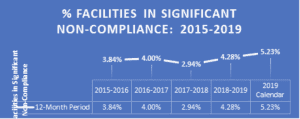For Immediate Release: Wednesday, July 22, 2020
Contact: Jerry Phillips (850) 877-8097; Kirsten Stade [email protected]
Florida Eco-Noncompliance Rises as Enforcement Wanes
Governor DeSantis’ Pollution Control Record Even Weaker Than Scott’s
Tallahassee — Despite pledges by Governor Ron DeSantis to strengthen pollution enforcement, state records show declines in virtually all meaningful measures, according to a new analysis by Public Employees for Environmental Responsibility (PEER). Notably, violations and significant noncompliance with pollution limits are growing while major enforcement actions are declining.
PEER examined Florida Department of Environmental Protection (DEP) files covering 2019, Gov. DeSantis’ first year in office. Key findings from that review include –
- While the number of DEP inspections increased in 2019, inspectors found a higher percentage of violations, including an almost doubling of the percentage of facilities found in significant noncompliance, continuing a troubling trend;
- Although higher noncompliance should have resulted in more enforcement, the opposite occurred, with the rate of enforcement sliding statewide, from already historically low levels, by another 4% in the past year; and
- Not only did the enforcement rate drop, but DEP’s oversight over noncompliant facilities also shrunk, allowing more violators to pay small penalties rather than fix problems.
“Today, approximately one-third of facilities statewide are in violation of pollution standards,” stated Florida PEER Director Jerry Phillips, a former DEP enforcement attorney who has been tracking this data for more than a decade. “The data show an agency that simply cannot bring itself to take formal enforcement against polluters, even major violators, in the face of rising rates of noncompliance.”
The most disturbing findings came from DEP’s domestic wastewater program. This is the area where Gov. DeSantis vowed a crackdown to reduce discharges of nutrient-laden wastewater feeding toxic algal blooms and red tides which have plagued state waters.
Instead of improvement in 2019, the wastewater program experienced a double whammy: While inspections rose 265% over 2018, noncompliance spiked with a one-year rise from 828 to 2231 such facilities; and a drop in new enforcement cases, yielding only an anemic 3% rate of enforcement, down 8% from 2018, the lowest levels in any DEP programs. PEER points to DEP’s mishandling of chronic violations by Orlando’s wastewater plant as a prime example.
“Today, even if polluters are caught, enforcement is less likely, penalties are likely to be smaller and then, even if assessed, less likely to be collected.” added Phillips, pointing to Florida’s “traffic-ticket” approach to pollution enforcement. “While there have been some superficial improvements, bottom line pollution indicators for Florida are abysmal, and getting worse.”
###
See decline in Florida’s environmental compliance

Look at rise in percentage of facilities in significant noncompliance

View the total number of DEP enforcement cases
